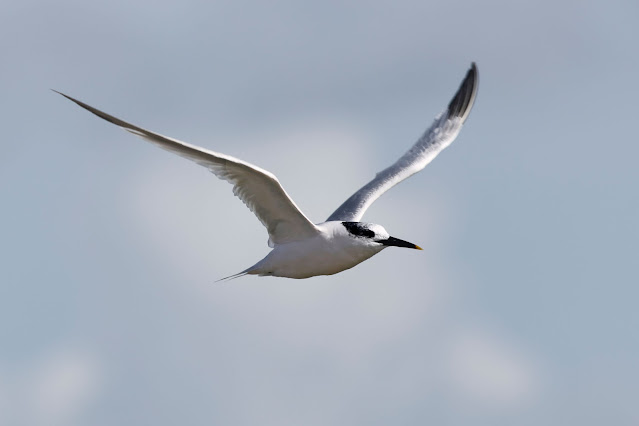Two days of heavy rain and strong winds moved away to provide a calm and still morning, I was meeting Ian at the Bridge Street car park just after sunrise and we set off along the canal path towards the Posbrook Floods.
Over the last few days there have been good numbers of herons and egrets on the floods due to the fish being stranded in the flood from the river. As we approached we could see the white of egrets and as we got closer we were able to identify them as Great Egrets.
As well as the herons and egrets the water was boiling with Cormorants as they chased the fish underwater.
We decided to see if we could get a view from the side footpath, with the heavy rain over the last few day we expected it to be flooded, which it was, but we were able to find a place where we could see across the floods from the south looking north.
All four Great Egrets along with a Little Egret and Grey Heron
There was something missing, the Glossy Ibis, another species that is extending its range into the UK. We decided to make our way to the viewing point over the Bridge Street floods. However we stopped to check the horse filed just past the bridge.
There was a lot of movement in the bushes around the field and we walked up the path to see what was there. Scanning there were Meadow Pipits and with them a single Whinchat, which promptly disappeared. It was mainly Blackcap and Whitethroats, but there were also a few Chiffchaff and probably, local Greenfinch. We were able to get some photographs.
Whitethroats
A male Blackcap
And a female Blackcap
As we made our way to the car park a Red Admiral was catching the morning sunshine.
At the view point there is a much better view across the floods, the grass is high and forms a barrier to see clearly from the Canal Path. At first the only thing of interest was the Egyptian Goose that appears to have an injured wing. But out of the thick grass and vegetation came one Glossy Ibis.
Scanning across the fields I picked up a lone Cattle Egret amongst the cattle, but it was very, very distant.
We decided to head down to Hill Head, a Grey Phalarope was reported on the previous day and seen this morning. As we arrived on the sea wall I noticed a Wheatear perched on one of the benches. It was still there after we had parked and was quite happy to allow us to get quite close.
Then a car drove by and it flew off on to the reserve.
There was no sign of the phalarope, but we spent some time looking, eventually we decided to check in at the visitor centre and then walk back to go on to the reserve and the Meon Shore Hide.
Stopping at the bridge a Migrant Hawker was hunting around the reeds.
The Black-tailed Godwits were feeding in a line almost as if they were conducting a search sweep
It was nice to see that one Teal was almost out of eclipse plumage, although this means that summer is sliding away and winter is coming.
The Shoveler are almost there.
The only small waders seen were a single Common Sandpiper at the back of the scrape and Dunlin, two of which came close to the hide.
A pair of Stock Dove coming in for a drink.
There were Snipe about, but not as obvious as in previous visits, and it was a case of looking hard to find them.
We decided to walk round to the Spurgin Hide if just for a break. After about five minutes in the hide a Kingfisher appeared on one of the strategically positioned posts.
A male
Then appeared a little later at the back of the pool and aside from them there was very little else to keep us entertained. We decided to go back to the sea wall to see if the phalarope was about, on the way we stopped for a very showy Migrant Hawker.
There was nothing on the sea in front of the chalets so we headed towards the sailing club. There was a flock of Black-headed Gulls by the sea wall and with them two Sandwich Terns.
Here a juvenile lacking the yellow tip to end of the bill
Another of those days when you think it has not been that good, but Glossy Ibis, Great Egret and Cattle Egret are quality birds.




























































No comments:
Post a Comment